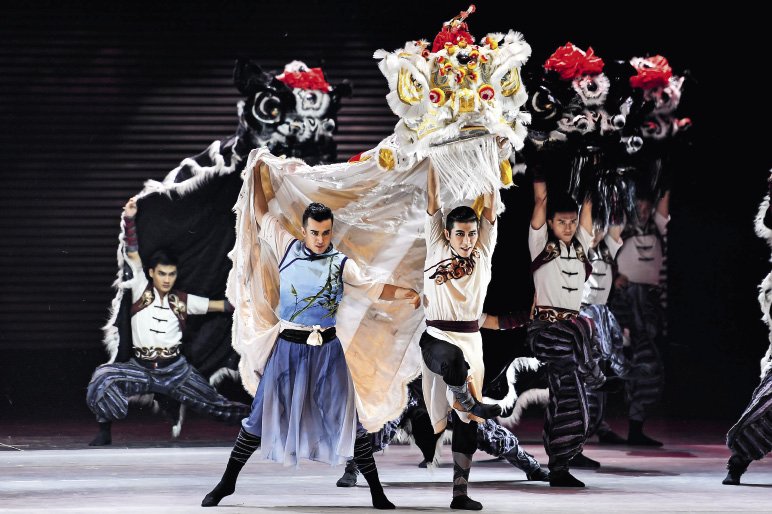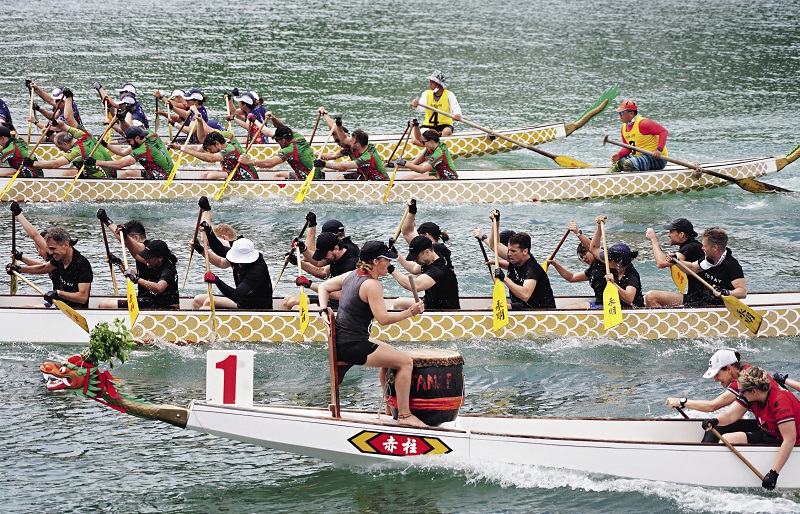Guangdong, Hong Kong, and Macao, all deeply rooted in Lingnan culture, are embracing burgeoning cultural development in the new era thanks to a slew of culture-oriented plans.
Amidst the warm breezes of March, engineers and construction workers wearing safety helmets are busy with building a giant book store complex in Qianhai, in south China’s Shenzhen City. Scheduled for completion by the end of 2024, the complex will be one of Shenzhen’s top 10 cultural facilities, and inject new cultural impetus into the development of the Guangdong-Hong Kong-Macao Greater Bay Area (GBA).

Animation-Comic-Game Hong Kong kicks off at the Hong Kong Convention and Exhibition Centre on July 24, 2021. The Guangdong-Hong Kong-Macao Greater Bay Area ACG Culture Association holds its inaugural ceremony on the same day.
Promoting Intangible Cultural Heritage
“The Greater Bay Area is a place of cultural profundity. This can be seen from local public cultural amenities and the inheritance and innovation on intangible cultural heritage,” said Liu Wei, director of the Institute of International Studies of the Guangdong Academy of Social Sciences and secretary-general of the Guangdong Academy of Greater Bay Area Studies.
People in Guangdong, Hong Kong, and Macao share common roots of the Lingnan culture. Based on geographical location and history, local people have created an inclusive ocean-based culture.
To promote the unique Lingnan culture and integrated development of the Greater Bay Area, MGM Macao and the Guangzhou Song and Dance Theater jointly launched a brand new ethnic dance drama which combines the elements of lion dancing, local martial art, dancing, and traditional intangible cultural heritage. This show was performed 32 times in four rounds between July 2021 and February 2022.
Efforts have been made to engage more people in Cantonese opera. In September 2021, Guan Qing, a leading Cantonese opera actress and an inheritor of the Guangdong intangible cultural heritage of Cantonese opera, led a performing group of Cantonese opera enthusiasts on a tour of Guangzhou and Foshan. The general public were offered a chance to experience the charm of the opera in person.
Zeng Xiaomin is also an inheritor of Cantonese opera. She is director of the Guangdong Cantonese Opera Theater, and a deputy to the National People’s Congress (NPC). At this year’s annual legislative meeting, Zeng made a proposal of building a dedicated Cantonese opera academy to promote the development of the opera as a cultural heritage. The academy should offer training programs like choreography, directing, performing, and theatrical music, she said.
Yao Cho Fai, who grew up in Hong Kong, is Chairman of the Board of Hong Kong Shanghai Alliance Holdings Limited. He welcomes the idea of building a cultural-oriented Greater Bay Area. He said, “We used to invite world renowned musicians and dancers to perform in Hong Kong. In the future, the city cluster in the Greater Bay Area will be a more attractive destination.”
“Guangdong boasts an inclusive Lingnan culture and popular Cantonese opera. Hong Kong, which is adjacent to Guangdong, is known as a place where the East meets the West,” Yao said. He believes that with intensified cultural communication and cooperation, the Greater Bay Area will become a robust cultural hub.

Dancers from the Guangzhou Song and Dance Theater perform a dance drama called Awakening Lion on the evening of June 25, 2019 at Guangzhou Friendship Theater, where the Guangdong-Hong Kong-Macao Greater Bay Area Culture and Arts Festival of the 2019 International Dance Season opens on the same day.
Cultural Tourism Creates Quality Standard of Life
A number of scenic spots can be viewed from cruise rides in the Greater Bay Area (GBA), such as Tsing Ma Bridge, Victoria Harbor, Cheung Chau Island, Lantau Island, and White Dolphin Nature Reserve. Riding a cruise in the Shenzhen Shekou Cruise Terminal, visitors can enjoy both natural views and various cultural performances.
Liu Wei said that the GBA sea-view trourism program is of great significance to advancing GBA cooperation. Already, four routes for the the sightseeing program have been opened: Shenzhen Bay route, Hong Kong-Zhuhai-Macao Bridge route, Qianhai Bay route, and Lantau Island route. The tours also offer a range of Chinese and Western cultural activities, such as Peking opera, Cantonese opera, lion dance performances, Chinese poem games, as well as exotic singing and dancing and magic shows staged by the local theme park – the Window of the World.
At the beginning of 2022, the Guangdong provincial government released a slew of planning documents and guidelines on boosting culture and tourism and building the Greater Bay Area into a world-leading tourist destination. Liu headed an expert panel for the formulation of one of the documents. He said that the policy design will inject new impetus to cultural development in the Greater Bay Area. “The release of the documents showed that cultural advancement is a top priority to the provincial leadership in developing the Greater Bay Area, and that integrated cultural and tourism development is a trend,” Liu noted.
In Liu’s view, culture is playing an ever-increasing important role in the development of the Greater Bay Area as it becomes a window for the world to understand China. He called for greater efforts to tap into local cultural heritage and advance integrated cultural and tourism development.
In fact, Guangdong has been a leader in developing cultural tourism. The added value of cultural industry, which shores up the provincial economy, has ranked first nationwide for 18 consecutive years. During the period of the 13th Five-Year Plan (2016-2020), the added value of cultural industry in the province grew at an average annual rate of over 10 percent, accounting for more than 5 percent of the provincial GDP for years.
Meanwhile, Hong Kong and Macao, as international metropolises, popular tourist destinations and recreational centers, attract streams of international tourists every year. With complementary tourism types and cultural connotations in Guangdong Province and those two neighboring places, the Greater Bay Area is emerging as an influential world-class tourist destination.

The Stanley Dragon Boat 2021 with all the local competitors joining in takes place at the Stanley Main Beach on June 14, 2021, the exact day of the Dragon Boat Festival.
More Opportunities Across the Shenzhen River
Deepening exchanges among young people from Hong Kong, Macao, and the mainland is a top priority for cultural development in the Greater Bay Area. Such exchanges will help young people better relate to the Lingnan culture, and understand the Chinese culture as a whole.
The central government has been launching an annual exchange program targeting university students for 17 years in a row. Each year, around 150 young students from Hong Kong and Macao were invited to Beijing and Shanghai to experience development on the mainland. Affected by the COVID-19 pandemic, the program was moved online during the past two years. Organizers managed to arrange virtual tours to the Palace Museum, Beijing Planetarium, and the Ancient Observatory, and on-site visit of the National Museum of China and the Meet Dunhuang Light Show. The activities helped broaden young people’s horizons and knowledge, said Liu Wei.
Local governments in Guangdong, Hong Kong and Macao jointly launched a brand event for youth exchanges in 2009. It was included in the planning documents for the development of the Greater Bay Area. When the annual event was held in 2021, the 13th of its kind, participants visited the A-Ma Temple, Handover Gifts Museum of Macao, Ruins of Saint Paul’s, and other landmarks in Macao.
Today, there is a popular saying in Hong Kong, “There are more opportunities across the Shenzhen River.” Yao Cho Fai, who has been committed to youth exchange programs, said that in order to ensure a long-term prosperity and stability of Hong Kong, efforts should be made to see to it that the “one country, two systems” policy will be carried on and developed by the next generation. From this point of view, youth exchanges are of strategic significance, Yao said.
At the 2022 session of the NPC, he submitted a proposal on using the latest achievements in industry, research institutes and universities to enhance young students’ national identity. Through personal surveys and study, he found that some Hong Kong youth lack understanding of the history of the country and the Chinese nation, as well as the country’s industrial, economic, and technological development. Thus he made the proposal.
“Hong Kong has a population of only 7.5 million, while the Greater Bay Area has 65 million. We need to expand from a market of merely 7.5 million people to the one with more than 60 million for further development,” said Yao. He hopes the younger generation in Hong Kong can recognize the development potential of the Greater Bay Area, seize the opportunity, and pursue education or career development in the Greater Bay Area to realize their dreams.